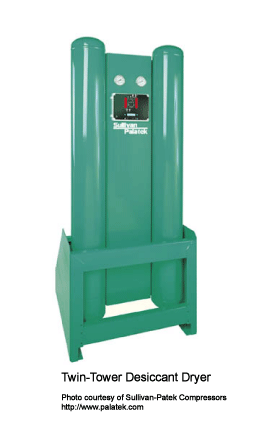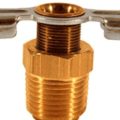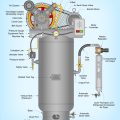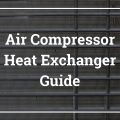Hey! This site is reader-supported and we earn commissions if you purchase products from retailers after clicking on a link from our site.
A desiccant dryer can sometimes be confused with a deliquescent dryer. Both types of compressed air dryers contain substances that are used to absorb, or adsorb, moisture and extract water vapour from an enclosed environment; these substances are known as desiccants.
This page will provide you with all the relevant information on desiccant air dryers.
Table of Contents
- What Is A Desiccant Dryer?
- How Does A Desiccant Dyer work?
- Desiccant Dryer Regeneration
- Desiccant Dryers Efficiency
- Desiccant Dryer Dust
- Oil Carry Over From The Compressor
- FAQs (Frequently Asked Questions)
What Is A Desiccant Dryer?
Many people have found small packets of chemicals inside the packaging of electronic or photographic equipment, placed there to absorb water vapor and to maintain the atmosphere inside the package in a dry state.
This protects sensitive equipment from moisture damage. These are a form of desiccant dryer. Common desiccants, or otherwise know, compressed air drying agents, are silica gel and aluminum oxide.
Desiccant air dryers are needed in compressed air systems to remove the water vapor from the compressed air. It’s natural for the flow of compressed air to be saturated with water vapor and in the case of air cooled compressors, the air may be warmer than ambient temperature.
Allowing this wet air to be released down the compressed air systems pipes or tubing and and force the pipes to potentially rust, whilst collecting any dirt and oil in the piping and flowing it towards your pneumatic tools. This collection of particulates if not filtered properly can cause damage to your tools.
Visit our Compressed Air Filtration Guide – Types of Filters & Their Purpose for more information on air compressor filters.
How Does A Desiccant Dyer work?
The main component in a desiccant dryer is the beds of a chemical that will remove the water vapor from the compressed air via an adsorption process as the air passes through it. Activated alumina tends to be the most common desiccant chemical and can hold only os much water vapor.
Desiccant dryers can only hold so much water vapor, there needs to be a way to regenerate it once the desiccant becomes saturated. Desiccant dryers tend to be designed with two possible paths for the compressed air through two identical desiccant beds that are located inside two pressure vessels/dryer towers like in the image below.

When one of the towers is drying the compressed air, the other will be in its regeneration cycle. This desiccant dryer will have controls and a system of valves that will switch towers on a regular basis without interrupting the flow of compressed air through it.
Desiccant Dryer Regeneration
A desiccant dryer is usually a larger, whole-plant drying system, and rather than the desiccant deliquescing into a water chemical slurry in the bottom of the tank, a different desiccant material would be used, and this chemical desiccant will absorb water, and will need to be regenerated.
The desiccant chemical regeneration would take place either by directing dry air through the wetter desiccant bed from another desiccant tower. This happens if the system is of the Twin Tower Desiccant Dryer type, or by depressurization of that single tower and sometimes the application of heat to dry the desiccant.
The application of the dry air or heat removes collected moisture from the desiccant material. In time, and after going through the drying cycle, moist compressed air is once again directed through that particular tower with the desiccant bed dry and ready to strip moisture and water vapor from the compressed air stream again.
The use of a desiccant dryer often means that the dew point of the compressed air , after it leaves the dryer, is at the minus degree level.
When the desiccant dryer is functioning properly, after compressed air has been through an appropriately sized desiccant dryer, there should not be any condensate formed in the downstream air lines. This is because the ambient temperature in the rest of the plant should be at higher temperature than the dew point of the desiccant-dried air. Any minute quantities of water vapour left in the compressed air should never condense into free water in the air lines under these circumstances.
Desiccant Dryers Efficiency
The key driver of energy consumption for desiccant dryers is the cost of its regeneration and after that, the effect that the pressure differential has across the dryer and any associated filters on the air compressor systems efficiency.
The regeneration or cooling purge is typically based on a percentage of the full-load rating of the air dryer and not the percentage of the actual flow of air through the unit.
Heated dryers use lower combined purge and cooling flow than heatless dryers do, but they have an electric heater that in uncontrolled dryers will heat the desiccant for a fixed period of time. The heater will cycle on less often of course if the desiccant bed is not fully saturated, but the cooling purge will typically remain fixed for the remainder of its cycle in all conditions.
The desiccant within the dryer must always be protected from fouling by separating and removing the free water and compressor lubricant that may be vacant in the compressed air at the inlet. If the desiccant becomes contaminated it will lose its ability to remove moisture and therefore the need to protect the dryer from this is desired. Filters can be installed at the inlet ti remove particulates entering the dryer and at the outlet to protect the downstream from desiccant dust.
Making Desiccant Dryers More Efficient
One way of making desiccant dryers more efficient is by applying dew-point controls to the system. The dew controls turn off the purge flow on the regenerating side once the desiccant has been fully reactivated and this saves compressed air that would otherwise have been wasted because of the dryer partial loading.
This switching of dryer towers is delayed until the dew-point control senses when the desiccant has reach its point of saturation, sometimes this may be the elapsing of the maximum period of time – depending on the dryer.
There are a number of other efficiency measures that can be taken on desiccant dryers and these include but are not limited to:
- Sizing your dryer effectively – size the dryer for worst case conditions i.e. sizing them larger that the capacity of the compressor system connected
- Calibrating dew-point controls – the sensors can become contaminated and cause malfunction so must be checked regularly against an independent meter
- Check purge adjustment regularly – ensure the purge flow doesn’t become out of adjustment
- Maintaining filters and separators – filters will cause excessive pressure differential if not maintained, whilst the separators must be vigilant to keep free water out
- Maintaining switch valves – failure to the valves can result in wet air entering the dryer and possible regenerating failure
- Monitor dryer hours – keep a log of the dryer and percentage savings (some dryers will report this automatically) and compare them week to week to ensure nothing has gone wrong
Desiccant Dryer Dust
There is the potential for dust from the desiccant to travel downstream with the compressed air.
If the air-using application is sensitive to that, desiccant dust must be removed with a general purpose filter before the air gets to the equipment. Check with the supplier of the desiccant as to the dust issue for their media, and their filter recommendation to deal with it.
In order to ensure that the desiccant in the dryer lasts as long as possible, you’ll want a general purpose filter upstream from the compressed air desiccant dryer to strip out any free water, and as any airborne debris before it gets to the desiccant chemical.
In operation, deliquescent dryers, typically smaller and often in an in-line installation, will generate a slurry of water and desiccant chemical that drips down to the bottom of the desiccant dryer housing. That slurry must be drained periodically. To ensure this happens, consider an auto-drain to clear the buildup regularly, without having to rely on a maintenance person to remember to do it.
Oil Carry Over From The Compressor
The effectiveness of the desiccant chemical can be severely diminished or eliminated if airborne oil enters the desiccant bed.
If your compressor has oil carryover from the compressor pump into the compressed air stream a coalescent air filter can be installed upstream from the desiccant dryer, and after the general purpose filter to remove oil from the air stream.
For more information on Coalescent Filters please visit our coalescent filters for air compressors guide!
FAQs (Frequently Asked Questions)
A desiccant air dryer is used on compressed air systems to remove the water vapor from the compressed air so that the piping network and pneumatic tools down the line are protected from damage and are able to deliver the highest quality of air possible.
Desiccant dryers are extremely good and reliable air dryers if they are maintained appropriately. Regular checks and maintenance can allow you to successfully dry air for anything up to 5 years depending on the type of desiccant dryer.
If the desiccant dryers are well maintained (including their filters and separators) they should be able to last up to 5 years if they’re heatless dryers. Whilst heat generated dryers should last between 2 to 3 years.
The three common desiccants used in compressed air dryers are activated alumina, silica gel or molecular sieve.
If you have any questions regarding desiccant compressed air dryers, then please leave a comment below, with a photo if applicable, so that someone can help you!





